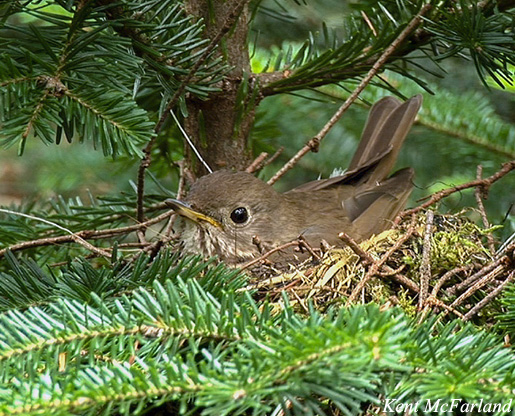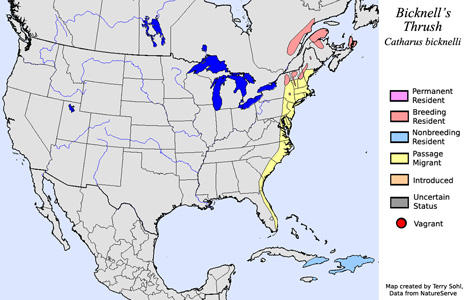Bicknell's Thrush
Catharus bicknelli
| Length: 6.25 inches | Wingspan: 10-11 inches | Seasonality: Non-resident in South Dakota |
| ID Keys: Grayish-brown upperparts, faint eye ring, dark-spots on breast, light underparts | ||
 The
Bicknell's Thrush is a small thrush with a small breeding range, in
scattered locations in the northeastern United States and southeastern
Canada. They were once considered a sub-species of the Gray-cheeked
Thrush (only named a distinct species in 1995), and can be difficult to
distinguish from that species. Hearing a singing Bicknell's Thrush is
the most reliable means of identification. The species has a small
breeding range and populations have been in strong decline. Land-use
change and climate impacts are thought to be behind the decline.
The
Bicknell's Thrush is a small thrush with a small breeding range, in
scattered locations in the northeastern United States and southeastern
Canada. They were once considered a sub-species of the Gray-cheeked
Thrush (only named a distinct species in 1995), and can be difficult to
distinguish from that species. Hearing a singing Bicknell's Thrush is
the most reliable means of identification. The species has a small
breeding range and populations have been in strong decline. Land-use
change and climate impacts are thought to be behind the decline.
Habitat: Found in high-elevation forests near the treeline, usually dominated by balsam fir. Such habitats are scattered and uncommon in their breeding range.
Diet: Feeds on insects, spiders, earthworms, and other small creatures. They will also consume fruits and berries.
Behavior: Typically forages on the ground or low in vegetation.
Nesting: The nest is usually placed relatively low in a small fir tree, between 2 and 12 feet fromt the ground. The nest is made of grasses, bits of bark, moss, and mud. The female lays between three and six eggs. The female alone incubates the eggs. Both parents help to feed the young upon hatching.
Song: The song of a Bicknell's Thrush is a nasal-sounding series of descending phrases.
Migration: Migratory, breeding in the northeastern United States and southeastern Canada, and wintering in scattered locations in the Caribbean.
Feeders: Has been known to attend feeders for offered fruit.
Interactive eBird map: Click here to access an interactive eBird map of Bicknell Thrush sightings
Similar Species: Gray-cheeked Thrush, Swainson's Thrush. Differentiation from Gray-cheeked Thrush is difficult. Overall, Bicknell's Thrush is smaller than Gray-cheeked Thrush and is slightly warmer brown. Idenfication by song is the most reliable means of distinguishing between them.
Conservation Status: Populations have been in a strong decline. Land use change and climate change have both been implicated as potential causes behind the decline. In their limited breeding range, the forestry practices of thinning or clear-cutting makes habitat unsuitable for Bicknell's Thrush. Urban and recreational development, as well as agricultural land use, also threatens local populations. In the 1960s to 1980s, acid rain was thought to have also degraded habitat of the species. As a result of declining populations and continued threats, the IUCN lists the Bicknell's Thrush as a "vulnerable" species.
Further Information: 1) Cornell's All About Birds - Bicknell's Thrush
2) Audubon.org - Bicknell's Thrush
3) Whatbird.com - Bicknell's Thrush
Photo Information: Photo taken by Kent McFarland - Photo licensed under Creative Commons Attribution Non-Commercial 2.0 Generic license.
| Click below for a higher-resolution map |
 |
| South Dakota Status: Non-resident in South Dakota |
Additional Bicknell's Thrush Photos (coming soon!!)
